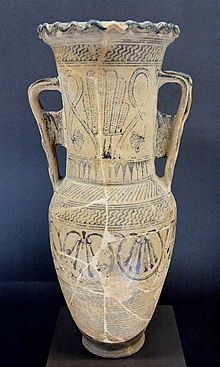
A loutrophoros (Ancient Greek: λουτροφόρος, romanized: loutrophóros, lit. 'loutrophoros'; Greek etymology: λουτρόν/loutron and φέρω/pherō, English translation: "bathwater" and "carry") is a distinctive type of Greek pottery vessel characterized by an elongated neck with two handles. The loutrophoros was used to carry water for a bride's pre-nuptial ritual bath, and in funeral rituals, and was placed in the tombs of the unmarried. The loutrophoros itself is a motif for Greek tombstones, either as a relief (for instance, the lekythos on the Stele of Panaetius) or as a stone vessel. There are many in the funeral area at the Kerameikos in Athens, some of which are now preserved in the National Archaeological Museum of Athens.
Gallery
-
Attic black-figure loutrophoros-hydria; late 6th century BC
-
Attic black-figure loutrophoros-amphora with a prothesis scene, 510-500 BC
-
 Keramikos Museum, Athens, Marble loutrophoros from the grave of Agathon and Sosykrates
Keramikos Museum, Athens, Marble loutrophoros from the grave of Agathon and Sosykrates
-
 Apulian egg-shaped loutrophoros (Apulian typus I, variant I), 330 BC
Apulian egg-shaped loutrophoros (Apulian typus I, variant I), 330 BC
-
 Oversize ("huge") Apulian cylinder-shaped loutrophoros (Apulian typus II, variant I), 330 BC
Oversize ("huge") Apulian cylinder-shaped loutrophoros (Apulian typus II, variant I), 330 BC
-
 Apulian cylinder-shaped loutrophoros (Apulian typus II, variant II) by the Baltimore Painter; c. 330 BC; Museo Arqueológico Nacional de España (1998/92/2)
Apulian cylinder-shaped loutrophoros (Apulian typus II, variant II) by the Baltimore Painter; c. 330 BC; Museo Arqueológico Nacional de España (1998/92/2)
See also
References
- Richter, p. 57.
Sources
- Richter, Gisela M. A. (1928). A Newly Acquired Loutrophoros. The Metropolitan Museum of Art Bulletin, Vol. 23, No. 2, Part 1, pp. 54–57.
Further reading
- Kokula, Gerit (1984). Marmorlutrophoren . Berlin: Gebr. Mann, ISBN 3-7861-1391-2 (in German).
- Mösch-Klingele, Rosmarie (2010). Braut ohne Bräutigam. Schwarz- und rotfigurige Lutrophoren als Spiegel gesellschaftlicher Veränderungen in Athen . Mainz: Philipp von Zabern, ISBN 978-3-8053-4094-6 (in German).
- Παπαδοπούλου-Κανελλοπούλου, Χαρίκλεια (1997). Ιερό της Νύμφης. Μελανόμορφες λουτροφόροι . Athens, ISBN 960-214-104-2 (in Greek).
External links
| Greek vase shapes | |
|---|---|
| Wine vessels | |
| Water vessels | |
| Mixing vessels | |
| Cookware | |
| Tableware | |
| Perfume, oil, and wedding | |
| Funerary and religious | |
| Storage | |
| Other | |
This ceramic art and design-related article is a stub. You can help Misplaced Pages by expanding it. |
This article relating to archaeology in Greece is a stub. You can help Misplaced Pages by expanding it. |